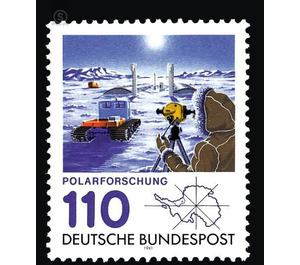Polar research - Germany / Federal Republic of Germany 1981 - 110 Pfennig
Theme: Devices, Items & Instruments
| Country | Germany / Federal Republic of Germany |
| Issue Date | 1981 |
| Face Value | 110.00 |
| Color | white blue |
| Perforation | K 14 |
| Printing Type | Six-color offset printing |
| Stamp Type | Postage stamp |
| Item Type | Stamp |
| Chronological Issue Number | 973 |
| Chronological Chapter | GER-BRD |
| SID | 350591 |
| In 47 Wishlists | |
The reason for this was the accession of the Federal Republic of Germany to the Antarctic Treaty in 1979 and its acceptance into the group of Consultative States of the Antarctic Treaty in March 1981. On February 5, 1979, the Federal Republic of Germany joined the Antarctic Treaty signed in Washington on December 1, 1959, today 23 States The twelve signatory states are Argentina, Australia, Belgium, Chile, France, Great Britain, Japan, New Zealand, Norway, the Soviet Union, South Africa and the USA, as well as the eleven subsequent states Brazil, Bulgaria, Denmark, Federal Republic of Germany, GDR, Netherlands, Peru, Poland, Romania, Czechoslovakia and Uruguay. The purpose of the Antarctic Treaty is to maintain the integrity of the area south of the 60th parallel and to use it exclusively for peaceful purposes. All military measures and nuclear explosions of any kind are prohibited. The storage of radioactive waste is also prohibited. As the first non-armament treaty after the Second World War and the creation of the first nuclear-weapon-free zone, the Antarctic Treaty has gained importance. The Federal Republic of Germany endorses these objectives and is willing to support them. In order to facilitate international cooperation in research, the parties have agreed to exchange information on the planning of their programs, expeditions and stations, as well as scientific staff and scientific observations and results. The main decisions provided for by the Treaty are taken by the group of consultative States which, in addition to the twelve original signatory states, owns every other party to it which carries out significant scientific research in the Antarctic, such as the establishment of a scientific station and the sending of scientific expeditions Interest in exploring the Antarctic proves. In addition to the twelve first signatory states, in 1977 Poland became a member of the consultative round of the treaty. With the founding of the Alfred Wegener Institute for Polar Research in Bremerhaven in 1980, the construction of the polar research and supply vessel Polarstern in 1982, the first German Antarctic research station »Georg von Neumayer« was built by the Federal Republic of Germany Extensive research in the Antarctic created the conditions that led to its inclusion in the Consultative Round of the Antarctic Treaty on 3 March 1981. The Federal Republic of Germany is thus also a member of the states which, within the framework of the Antarctic Treaty, help shape international cooperation in the exploration of this area. the motif shows the German Antarctic winter research station »Georg von Neumayer« (70 ° 36 '45 "S, 8 ° 21'55" W). The research station serves as a geophysical observatory especially in the fields of meteorology, climatology, seismology and ice research. (Text: Federal Ministry for Research and Technology, Bonn)


